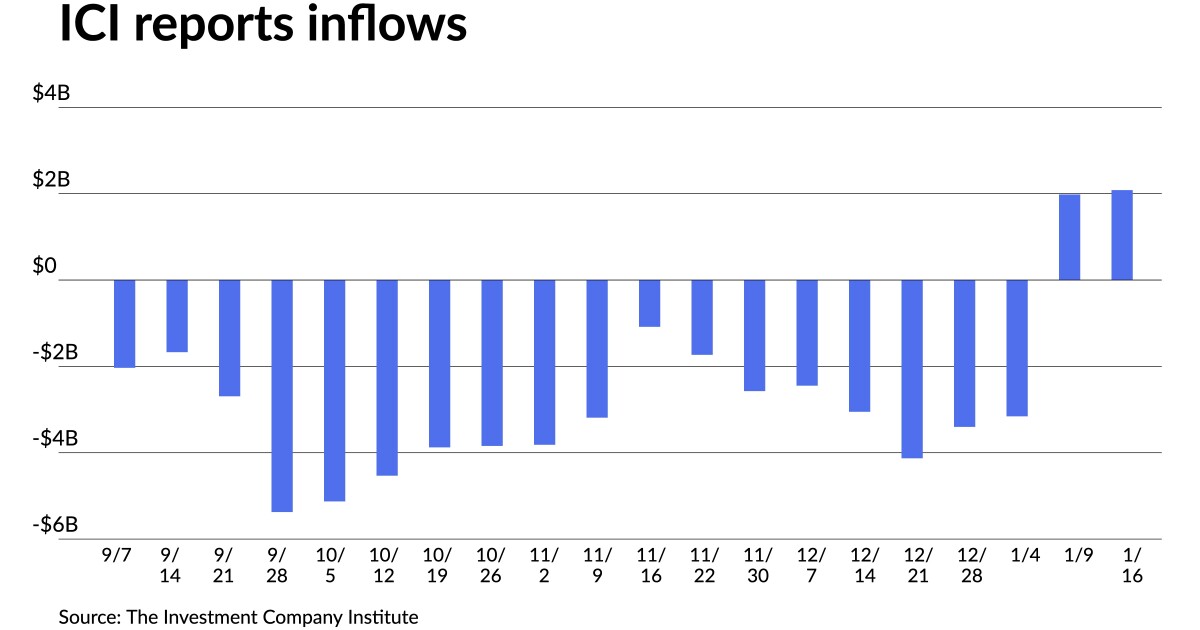Munis little changed, mutual fund inflows continue
6 min read
Municipals were little changed Wednesday, while U.S. Treasuries were firmer and equities ended mixed.
The three-year muni-UST ratio was at 55%, the five-year at 57%, the 10-year at 63% and the 30-year at 88%, according to Refinitiv MMD’s 3 p.m. ET read. ICE Data Services had the three at 54%, the five at 58%, the 10 at 64% and the 30 at 89% at 4 p.m.
It’s been a good start to 2023 for bonds, said R.J. Gallo, senior vice president and senior portfolio manager at Federated Hermes.
“The bond market is having another bullish reaction as yields are declining in both USTs and munis on the continued sort of evolution of the disinflation story,” he said. “That’s been the dominant factor, driving all fixed income, munis included, since the November CPI came in softer than expected.”
This, he said, “is a mirror image of what happened in most of 2022.”
Inflation started to rise in late 2021, and the Fed said it was transitory, but when “it proved not to be transitory, the Fed had to do a complete 180 and fight the inflation with aggressive rate hikes,” Gallo said.
“So a combination of rising inflation and tighter monetary policy … killed bond market returns through most of 2022,” he said. “And now, as the inflation story has now started to reverse — it’s not fully done in places; it’s still pretty high — and the market has turned with it.”
Market participants “tend to believe a huge down year will be followed by a strong up year (known as a reversion to the mean) — and history suggests this is usually true,” said Peter Hayes, head of BlackRock’s Municipal Bonds Group, and Sean Carney, BlackRock’s head of Municipal Strategy.
However, while they expect 2023 to be a “bounce back year,” they “don’t foresee the historical 13% average bounce back that has occurred after past negative return years.”
“We do not believe that the market can produce that level of returns in 2023 if the Fed remains active, thus we urge patience and caution during the first quarter of 2023, and perhaps throughout the first half of the year,” Hayes and Carney said.
“With the Fed making significant progress in hiking interest rates, headwinds should moderate in 2023,” said Vanguard municipal bond experts. “Following a year with $119 billion of outflows from municipal funds and ETFs, we expect the tide to turn.”
Individual investors and advisors had “allocations to municipals with yields barely over 1% at the beginning of 2022, then they should now salivate at the prospect of yields exceeding 3% (before adjusting for tax benefits),” they said.
With tax-loss harvesting opportunities ending, they “expect that high-earning investors will be motivated to increase their tax-exempt holdings over time.”
Retail investors, Hayes and Carney noted, “will bolster demand for short and intermediate munis, as they continue to prefer individual bonds at more attractive dollar prices and are more concerned with all-in yields rather than rich valuations.” Demand for the long end of the curve may take a bit longer, they said.
“However, if investors turn bullish on duration (likely Fed-related), then that could have an immediate impact on the market,” they said.
They expect fund flows to be mixed “during the first quarter — perhaps even through the first half of the year — but flows should firm up as the Fed moderates its rate-hiking pace.”
Still, Hayes and Carney said, “it will take multiple years to make up for the outflows seen in 2022,” believing “the market will recapture a quarter to a third of the 2022 outflows in 2023.”
While the tax-exempt primary market was busy at the start of last year, Vanguard strategists said, “higher rates stunted the pace of issuance later on.”
Per usual, the supply picture going forward is uncertain, they noted, but “future issuance will likely remain subdued as the cost of borrowing is higher and municipal balance sheets are still flush with cash from pandemic-era stimulus.”
Inflows continued with the Investment Company Institute reporting investors added $2.083 billion to mutual funds in the week ending Jan. 18, after $1.982 billion of inflows the previous week.
Exchange-traded funds saw inflows of $162 million after $654 million of inflows the week prior, per ICI data.
Both inflows and lower supply should support municipal valuations in 2023, the Vanguard strategists said. “The quick 4.1% rally in the fourth quarter indicated that these effects are underway,” they said.
The rebound “may lure more investors back with attractive yields and reduce the possibility of negative returns this year,” according to the Vanguard strategists.
“With tax-equivalent yields of 6.0% (or meaningfully higher for residents in high-tax states who invest in corresponding state funds), municipals offer great value compared with other fixed income sectors and potentially even equities — especially with the odds of a recession increasing,” they said.
While the peak in the credit cycle has likely been reached, Hayes and Carney said “municipal fundamentals remain on solid ground.”
“Surplus revenues and unprecedented federal aid have allowed states to accumulate reserves, retire debt and fortify pensions,” they said.
“Lower revenues, higher borrowing costs, and poor investment returns will pressure 2024 budgets,” but “excess reserves and limited capital needs provide near-term flexibility, while higher interest rates allow states to de-risk pension plans,” Hayes and Carney noted.
“Local governments and school districts that rely primarily upon property tax revenues have historically fared well during a recession, although stagnation or declines in housing values make tax hikes more unpopular,” they said.
“Rising wages for workers will be one of the largest pressures on state and local budgets,” but “depending on the severity of any recession in 2023, wage pressures could moderate,” according to Hayes and Carney.
In the primary market Wednesday, JPMorgan priced for the Nebraska Investment Finance Authority (/AA+//) $130 million of single-family housing revenue bonds. The first tranche, $85 million of non-AMT social bonds, 2023 Series A, saw all bonds priced at par: 3.5s of 3/2033, 3.55s of 9/2033, 4.125s of 9/2038, 4.35s of 9/2043, 4.55s of 9/2048 and 4.6s of 9/2053, callable 3/1/2032.
The second tranche, $45 million of taxables, 2023 Series B, saw all bonds price at par: 4.2s of 9/2023, 4.51s of 3/3028, 4/56s of 9/2028, 4.9s of 3/2031, 5s of 3/2050 and 5.58s of 9/2053, callable 3/1/2032.
In the competitive market, the Kansas Development Finance Authority (//AAA/) sold $152.200 million of revolving fund revenue bonds, Series 2023SRF (Kansas Department of Health and Environment), to Morgan Stanley, with 5s of 5/2024 at 2.27%, 5s of 2028 at 2.07%, 5s of 2033 at 2.22%, 5s of 2038 at 2.88%, 5s of 2043 at 3.09% and 5s of 2044 at 3.12%, callable 5/1/2033.
Secondary trading
Connecticut 4s of 2024 at 2.33%. NYC 5s of 2024 at 2.23% versus 2.51%-2.46% on 1/6. Washington 5s of 2025 at 2.22%. California 5s of 2025 at 2.12%.
Maryland 5s of 2027 at 2.09%-2.08%. Ohio 5s of 2028 at 2.12% versus 2.16% Tuesday. Georgia 5s of 2030 at 2.12% versus 2.14% Monday and 2.14%-2.15% Friday.
Triborough Bridge and Tunnel Authority 5s of 2034 at 2.41%-2.40% versus 2.85%-2.84% on 1/9 and 3.07%-3.12% original on 1/6. Maryland 5s of 2035 at 2.48%. NYC TFA 5s of 2035 at 2.67%-2.64% versus 2.66%-2.60% on 1/18 and 2.67% on 1/13.
Massachusetts 5s of 2052 at 3.53% versus 3.47%-3.45% on 1/19 and 3.67%-3.61% on 1/11.
AAA scales
Refinitiv MMD’s scale was bumped up to two basis points. The one-year was at 2.33% (unch) and 2.17% (unch) in two years. The five-year was at 2.05% (-2), the 10-year at 2.19% (-2) and the 30-year at 3.18% (unch) at 3 p.m.
The ICE AAA yield curve was little changed: at 2.29% (flat) in 2024 and 2.22% (flat) in 2025. The five-year was at 2.08% (flat), the 10-year was at 2.19% (flat) and the 30-year yield was at 3.21% (flat) at 4 p.m.
The IHS Markit municipal curve was bumped up to two basis points: 2.32% (unch) in 2024 and 2.13% (-2) in 2025. The five-year was at 2.06% (-2), the 10-year was at 2.18% (-2) and the 30-year yield was at 3.16% (-2) at a 4 p.m. read.
Bloomberg BVAL was bumped up to a basis point: 2.32% (unch) in 2024 and 2.15% (-1) in 2025. The five-year at 2.10% (unch), the 10-year at 2.21% (-1) and the 30-year at 3.21% (unch).
Treasuries were firmer.
The two-year UST was yielding 4.131% (-7), the three-year was at 3.837% (-2), the five-year at 3.553% (-2), the seven-year at 3.497% (-2), the 10-year at 3.446% (-1), the 20-year at 3.717% (-1) and the 30-year Treasury was yielding 3.601% (-1) at 4 p.m.
Primary to come:
The Triborough Bridge and Tunnel Authority is set to price $1 billion of general revenue refunding bonds, Series 2023A. Jefferies.
The Lake Travis Independent School District, Texas, (/AA+/AA+/) is set to price Thursday $300 million of unlimited tax school building bonds, Series 2023, serials 2024-2053. BOK Financial Securities.
The Spring Independent School District, Texas, (Aa2/AA-//) is set to price Thursday $297.945 million of unlimited tax school building bonds, Series 2023, serials 2024-2052. Siebert Williams Shank.
Competitive:
The Spartanburg County School District 5, South Carolina, (Aa1/AA//) is set to sell $100 million of GOs, Series 2023 (South Carolina School District Credit Enhancement Program) at 11 a.m. Eastern Thursday.







